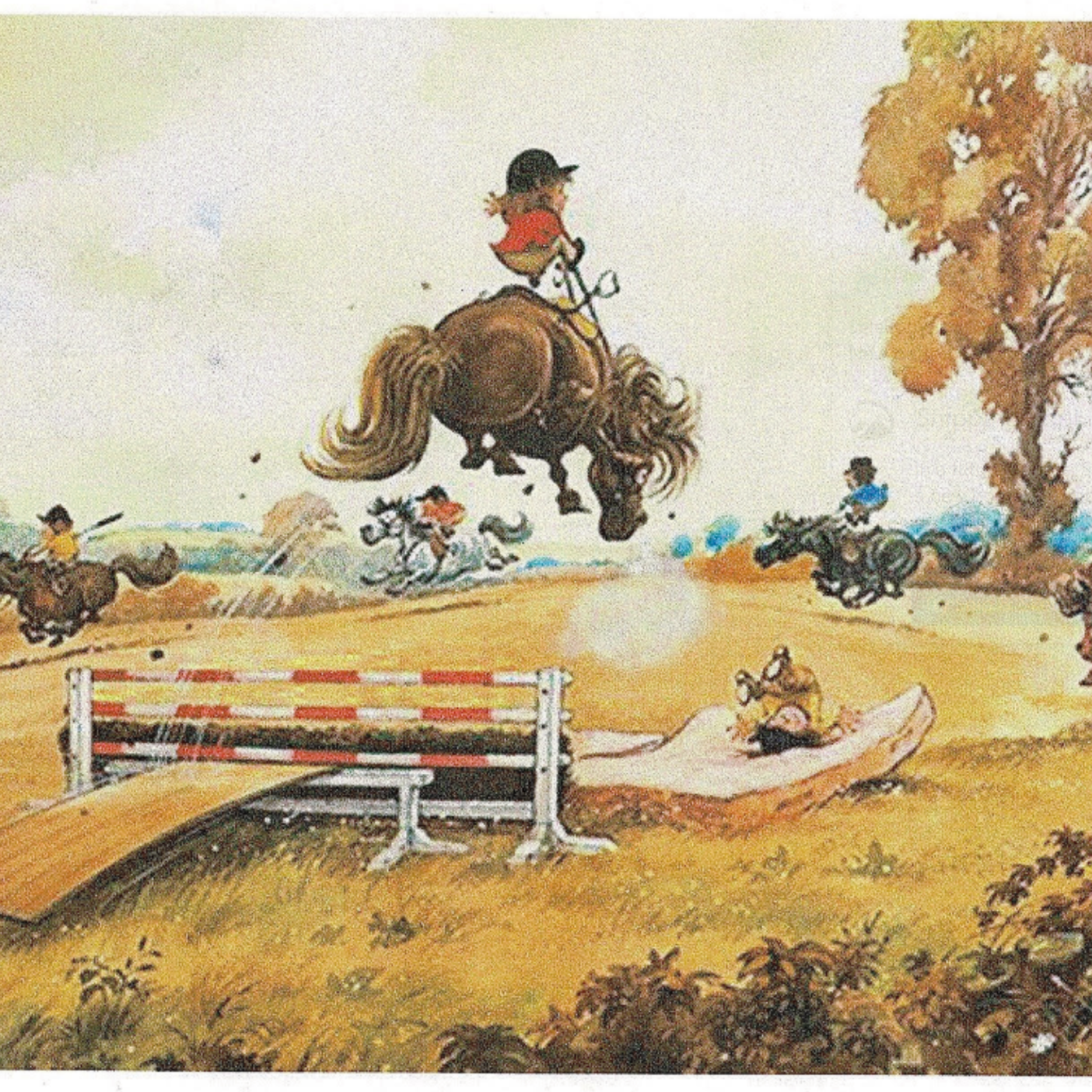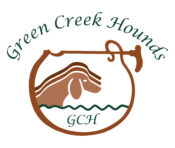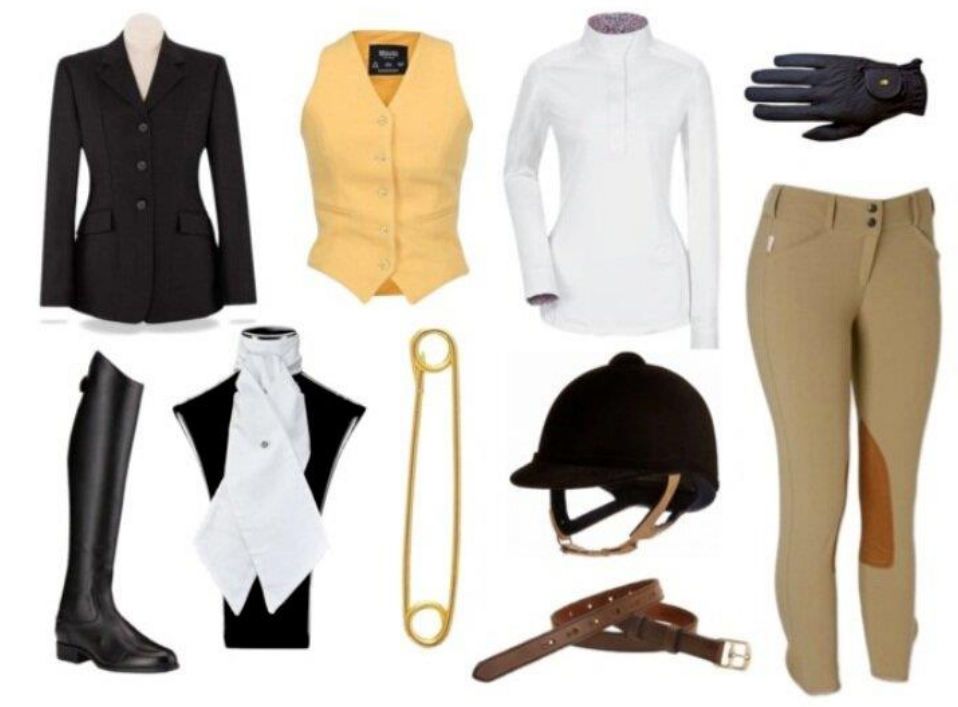Welcome to Green Creek
Green Creek Hounds was founded in 1988 and formally accepted by the MFHA in 1990. The territory consists of varied terrain in the North Carolina foothills of the Appalachian mountains, and typical quarry consists of red and gray fox, bobcat, and coyote. Three fields can accommodate any skill of rider, and many types of coop, log, and stone jumps are scattered throughout the territory. Typical hunting season runs September through March, but mounted trail rides are organized in the off-season for conditioning and hound training, and many non-mounted and social activities take place year-round.
The newly established pack consists of Pennmarydel hounds. Fields are kept close to the huntsman so that all can view hound work. The active fixtures are located around the Green Creek area of North Carolina. The hunt country is a medley of terrain with views of the Blue Ridge Mountains, making it hilly, and consists of woodlands and farmland, drained by numerous creeks and streams. Jumps consist of coops and logs. All are optional. The territory holds native red and gray fox, coyote and bobcat. A well-behaved, fit horse is recommended for the territory.
In addition to mounted activities, there are many social activities, including pot luck "Hunt Breakfasts" in the field or at the club house during hunt season; a formal hunt ball and auction, brewery tours and outings, boating days, barbeque dinners, and even kayaking on the Green River and Lakes Lure and Adger in summer.
About Us
Our History
Green Creek Hounds, founded in 1988 by Peg Secor, is known for its fine sport and welcoming atmosphere. Peg’s husband, Dick Secor, joined the effort in 1989 and John Burgess in early 1990. Seeing the need for a skilled hunter for the varied terrain, the team invited Jefferson 'Tot’ Goodwin to help the three Masters. In 1990, Goodwin became the Green Creek Huntsman, and Green Creek Hounds was accepted by the MFHA.

Green Creek’s Charter extends over thousands of acres through Polk and Cleveland Counties in North Carolina and Greenville and Union Counties in South Carolina. John Burgess and Dick Secor served until the mid-nineties. Mike Sheils joined Green Creek Hounds as a Master in the 90's. When he resigned Nan Hull and Pat Hale became Masters.
Peg Secor named Tot Goodwin Master in 1997 and he served as both Huntsman and Master for 21 years. Nan Hull resigned in 1999 and Peg Secor stepped down in 2000. Tom Jackson came on board as a Master in 2000. Roger Smith, the hunt’s largest land owner, joined the group of Masters in 2007. Tom and Roger served until August, 2011. Pat stayed on until the end of the 2011/12 season.
Kem Ketcham, Christi Fowler and Deborah Bundy were appointed Masters in August 2011. In March 2018 Jefferson "Tot" Goodwin retired as Master and Huntsman David Raley was appointed as huntsman. The original kennels on Sandy Plains Rd were replaced with a new facility at 6689 Poors Ford Rd Columbus NC, in Green Creek. At the end of the 2018-2019 season, Kem, Christi and Deborah retired and handed the reins over to Donald "DJ" Jefferis and Anna Dalton. DJ and Anna led the club through COVID, facing new and unique challenges, and in 2023, they turned the running of the hunt over to Anne Pierce, Jana Sloan, and Jillian Woolridge.
In the Spring of 2024, Tom Cadier was elected by the new Hunt Committee as the sole Master for the '24-'25 hunting season.
What is Foxhunting?
Mounted hunting with hounds has existed in America since colonial days. The development of the sport kept pace with the progress of the United States as it extended its influence across the Appalachians to the West Coast. Hounds of various types were brought from Europe by the early settlers. By 1900, the American Foxhound was the product of breeding their descendants with hounds that continued to be imported, mainly from England, Ireland and France.
The earliest record of the importation of hounds to this country was June 30, 1650, when Robert Brooke arrived in Maryland with his family, 28 servants and his hounds. By the early 1700s, mounted hunting with hounds mushroomed in Maryland and Virginia. In addition, hounds were used for other forms of hunting.
The first fox hunting club in this country was the Glocester Fox Hunting Club, established in 1766. During the revolution some of its members joined the First Troop, Philadelphia City Cavalry, a unit which still exists to this day, now a part of the National Guard.
George Washington was an avid foxhunter. His diaries make it evident that in adulthood, mounted hunting with hounds was his favorite sport and he often hunted with his good friend Lord Fairfax. Both Washington and Thomas Jefferson had packs of foxhounds. There were several packs of hounds in the Washington D.C. area and on one occasion, while Congress was in session, hounds ran near the capital. It is said that many Congress members ran outside to watch hounds, and some jumped on their horses and joined the chase.
The earliest established foxhound club was the Montreal Hunt in Canada in 1826. In the United States, the Piedmont Foxhounds were established in Virginia in 1840. Both packs continue successfully to this day.
In North American mounted hunting with hounds, the emphasis is on the chase. From conservation efforts and natural selection, fox populations in hunt country are exceptionally healthy. Since the 1980s, the coyote has increased in numbers throughout the United States and Canada. Many hunts now hunt coyotes, producing some wonderful hunts. Some hunts prefer to drag hunt (use an artificial scent) to provide sport where open land is unavailable. The course of the day’s hunt is choreographed through hunting country.
In October 1906, a letter was sent to Masters of the existing hunts, polling them to gauge their willingness to come together as a group. In February 1907, six masters met at the Waldorf Astoria in New York City. They formed the Masters of Foxhounds Association, with their primary purpose to settle disputes over hunting country. Over the course of more than 100 years, the MFHA evolved into the governing body for mounted hunting with hounds for Canada and the United States. While it is still involved in settling hunt country disputes, it also maintains the “Foxhound Stud Book,” the official registrar of foxhounds in North America. The MFHA lists approximately 70,000 hounds in the database and publishes an annual printed and online stud book. The MFHA sets the policies, rules and guidelines that govern the sport of mounted hunting with hounds. The MFHA holds seminars and other events to educate Masters and hunt staff.
There are 144 hunts in 35 states and three Canadian provinces. Accepted quarry is red and gray fox, coyote, bobcat and boar.
In 1938, the Hunt Staff Benefit & Development Foundation was formed to help professional hunt staff in financial need. In 2006 the MFHA launched the Professional Development Program, a year-long program to supplement the education of existing hunt staff.
From the Masters of Foxhounds Association website.


